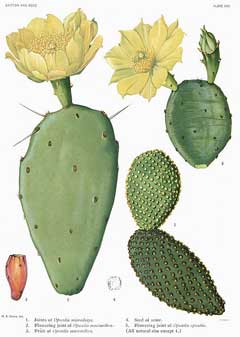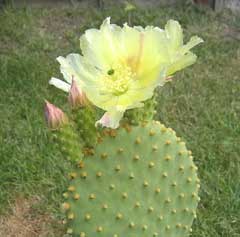 |
|
http://commons.wikimedia.org/wiki/File:Opuntia12_filtered.jpg |
 |
|
Translate this page:
Summary
Physical Characteristics

 Opuntia microdasys is an evergreen Perennial growing to 0.6 m (2ft) by 0.6 m (2ft in).
Opuntia microdasys is an evergreen Perennial growing to 0.6 m (2ft) by 0.6 m (2ft in).
See above for USDA hardiness. It is hardy to UK zone 8 and is not frost tender. It is in leaf all year, in flower from July to August. The species is hermaphrodite (has both male and female organs) and is pollinated by Insects.
Suitable for: light (sandy) and medium (loamy) soils and prefers well-drained soil. Suitable pH: mildly acid, neutral and basic (mildly alkaline) soils. It cannot grow in the shade. It prefers dry soil and can tolerate drought.
UK Hardiness Map
US Hardiness Map
Synonyms
Plant Habitats
Cultivated Beds; East Wall. By. South Wall. By.
Edible Uses
Edible Parts: Fruit Leaves Seed
Edible Uses: Gum
The following notes are for O. compressa. They almost certainly also apply to this species[K]. Fruit - raw, cooked or dried for later use[3, 46, 61, 62, 183]. Sweet and gelatinous[85]. Lean and insipid[95]. The unripe fruits can be added to soups etc, imparting an okra-like mucilaginous quality[183]. The fruit can hang on the plant all year round[160]. Be careful of the plants irritant hairs, see the notes above on toxicity. The fruit of O. microdasys is about 3cm in diameter[200]. Pads - cooked or raw[62, 160]. Watery and very mucilaginous[85]. Seed - briefly roasted then ground into a powder[62]. It is also used as a thickener[62].
References More on Edible Uses
Medicinal Uses
Plants For A Future can not take any responsibility for any adverse effects from the use of plants. Always seek advice from a professional before using a plant medicinally.
None known
References More on Medicinal Uses
The Bookshop: Edible Plant Books
Our Latest books on Perennial Plants For Food Forests and Permaculture Gardens in paperback or digital formats.

Edible Tropical Plants
Food Forest Plants for Hotter Conditions: 250+ Plants For Tropical Food Forests & Permaculture Gardens.
More

Edible Temperate Plants
Plants for Your Food Forest: 500 Plants for Temperate Food Forests & Permaculture Gardens.
More

More Books
PFAF have eight books available in paperback and digital formats. Browse the shop for more information.
Shop Now
Other Uses
Gum
The following notes are for O. ficus indica. They almost certainly also apply to this species[K]. A gum is obtained from the stem. It is used as a masticatory or mixed with oil to make candles[64]. The juice of the boiled stem segments is very sticky. It is added to plaster, whitewash etc to make it adhere better to walls[92].
Special Uses
References More on Other Uses
Cultivation details
Requires a sandy or very well-drained soil[160]. Prefers a pH in the range 6 to 7.5[200]. Plants must be kept fairly dry in winter but they like a reasonable supply of water in the growing season[200]. A position at the base of a south-facing wall or somewhere that can be protected from winter rain is best for this plant. Requires warmth and plenty of sun. Plants tolerate considerable neglect. This species is fairly cold tolerant and can succeed outdoors in a selected site in the milder areas of the country[200]. The stems develop brown marks at low temperatures[188]. Flowers are formed on plants that are more than 15cm tall[188].
References Carbon Farming Information and Carbon Sequestration Information
Temperature Converter
Type a value in the Celsius field to convert the value to Fahrenheit:
Fahrenheit:
The PFAF Bookshop
Plants For A Future have a number of books available in paperback and digital form. Book titles include Edible Plants, Edible Perennials, Edible Trees,Edible Shrubs, Woodland Gardening, and Temperate Food Forest Plants. Our new book is Food Forest Plants For Hotter Conditions (Tropical and Sub-Tropical).
Shop Now
Plant Propagation
Seed - sow early spring in a very well-drained compost in a greenhouse. When they are large enough to handle, prick the seedlings out into individual pots and grow them on in the greenhouse for at least their first two winters. Plant them out into their permanent positions in late spring or early summer, after the last expected frosts. Give the plants some protection from winter wet. Make sure you have some reserve plants in case those outdoors do not overwinter. Cuttings of leaf pads at any time in the growing season. Remove a pad from the plant and then leave it in a dry sunny place for a couple of days to ensure that the base is thoroughly dry and has begun to callous. Pot up into a sandy compost. Very easy, rooting quickly.
Other Names
If available other names are mentioned here
Native Range
NORTHERN AMERICA: United States (Texas), Mexico (Chihuahua, Coahuila de Zaragoza, Durango, Nuevo León, San Luis Potosí, Zacatecas, Guanajuato, Hidalgo, Jalisco, Querétaro)
Weed Potential
Right plant wrong place. We are currently updating this section.
Please note that a plant may be invasive in one area but may not in your area so it's worth checking.
Conservation Status
IUCN Red List of Threatened Plants Status :

| Related Plants
|
| Latin Name | Common Name | Habit | Height | Hardiness | Growth | Soil | Shade | Moisture | Edible | Medicinal | Other |
| Cylindropuntia spp. | Cholla | Perennial | 2.0 |
8-12
| S | LMH | SN | D | 3 | 0 | 4 |
| Opuntia compressa | Eastern Prickly Pear, Prickly Pear Cactus | Perennial | 0.2 |
8-10
| F | LM | N | D | 3 | 1 | 2 |
| Opuntia dillenii | Dillen prickly pear, | Perennial | 1.0 |
10-12
| M | LM | N | DM | 3 | 0 | 3 |
| Opuntia engelmannii | Engelmann’s Prickly Pear | Shrub | 2.5 |
8-11
| F | LMH | N | DM | 3 | 2 | 2 |
| Opuntia erinacea | Mojave Prickly Pear | Perennial | 0.5 |
8-11
| | LM | N | D | 2 | 0 | 2 |
| Opuntia ficus-indica | Prickly Pear, Barbary fig | Perennial | 5.0 |
8-11
| M | LM | N | D | 3 | 2 | 3 |
| Opuntia fragilis | Prickly Pear, Brittle pricklypear | Perennial | 0.1 |
7-10
| | LM | N | D | 2 | 1 | 2 |
| Opuntia howeyi | | Perennial | 0.0 |
-
| | LM | N | D | 2 | 0 | 2 |
| Opuntia humifusa | Eastern Prickly Pear | Shrub | 0.2 |
4-10
| M | LM | N | DM | 3 | 2 | 2 |
| Opuntia imbricata | Tree Chola | Perennial | 3.0 |
8-11
| | LM | N | D | 2 | 0 | 2 |
| Opuntia littoralis | Western Prickly Pear | Perennial | 0.6 |
-
| | LM | N | D | 2 | 0 | 2 |
| Opuntia macrorhiza | Twist-Spine Prickly Pear | Perennial | 0.1 |
8-11
| | LM | N | D | 2 | 0 | 2 |
| Opuntia phaeacantha | Bastard Fig, Tulip pricklypear | Perennial | 0.5 |
8-11
| | LM | N | D | 2 | 1 | 2 |
| Opuntia polyacantha | Plains Prickly Pear, El Paso pricklypear, Grizzlybear pricklypear, Navajo Bridge pricklypear, Hairsp | Perennial | 0.2 |
3-7
| | LM | N | D | 3 | 1 | 2 |
| Opuntia ramosissima | Branched Pencil Cholla | Perennial | 0.6 |
7-10
| | LM | N | D | 3 | 0 | 2 |
| Opuntia robusta | Wheel Cactus | Shrub | 2.0 |
9-11
| M | LM | N | DM | 4 | 0 | 2 |
| Opuntia tomentosa | Velvet prickly pear, Woollyjoint Pricklypear | Perennial | 4.5 |
9-12
| M | LM | N | DM | 3 | 0 | 3 |
|
Growth: S = slow M = medium F = fast. Soil: L = light (sandy) M = medium H = heavy (clay). pH: A = acid N = neutral B = basic (alkaline). Shade: F = full shade S = semi-shade N = no shade. Moisture: D = dry M = Moist We = wet Wa = water.
Now available:
Food Forest Plants for Mediterranean Conditions
350+ Perennial Plants For Mediterranean and Drier Food Forests and Permaculture Gardens.
[Paperback and eBook]
This is the third in Plants For A Future's series of plant guides for food forests tailored to
specific climate zones. Following volumes on temperate and tropical ecosystems, this book focuses
on species suited to Mediterranean conditions—regions with hot, dry summers and cool, wet winters,
often facing the added challenge of climate change.
Read More
Expert comment
Author
(Lehm.)Pfeiff.
Botanical References
200270
Links / References
For a list of references used on this page please go here
Readers comment
© 2010, Plants For A Future. Plants For A Future is a charitable company limited by guarantee, registered in England and Wales. Charity No. 1057719, Company No. 3204567.